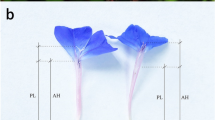Abstract
Erica gracilis is an important bedding plant in Northern Europe. Due to self-incompatibility, the development of new varieties was largely based on mutant selection from the predominant variety ’Glasers Rote‘. By crossing ’Glasers Rote‘ with wild types from South Africa in the 1980th, new cross-based varieties arose. Since the cultivation of cross-based varieties, precocious floral withering has been observed more frequently in production areas, suggesting that successful fertilization through open-pollination induces early floral senescence. A cluster analysis of current varieties based on AFLP markers confirmed the close relationship of old varieties and showed the expanded genetic diversity of cross-based varieties. Cross-experiments revealed that both, crosses of ’Glasers Rote‘-based genotypes with new cross-based genotypes and crosses between new genotypes, were successful. In contrast, selfings as well as crosses between old genotypes failed to produce seeds due to inhibition of pollen tube growth. Interestingly, we detected one self-compatible genotype, which provides new possibilities for breeding. No significant effect of open-pollination on the flowering period was observed by studying 16 genotypes, including old and new ones. This circumstance allows the mixed cultivation of different varieties in one production area. However, the flowering period was significantly affected by genotype and environment, suggesting that environmentally adapted varieties with long flowering periods can be bred.




Similar content being viewed by others
References
Bahnemann K (1982) Möglichkeiten zur Vorhersage und Beeinflussung des Blühens bei Erica gracilis Salisb. Dissertation, Universität Hannover
Behrend A, Gluschak A, Przybyla A, Hohe A (2015) Interploid crosses in heather (Calluna vulgaris). Sci Hortic 181:162–167
Biegler B (2012) Markt Report Blumen und Zierpflanzen. AMI Bericht 9/2012
BMEL (2014) Horticulture in Germany—facts and figures. Brochure of the German Federal Ministry of food and agriculture (BMEL):1–38
Borchert T, Gawenda I (2010) Development and application of high-throughput amplified fragment length polymorphism technique in Calluna vulgaris (Ericaceae). Electron J Biotechnol. https://doi.org/10.2225/vol13-issue2-fulltext-3
Borchert T, Eckardt K, Fuchs J, Krüger K, Hohe A (2009) ‘Who’s who’in two different flower types of Calluna vulgaris (Ericaceae): morphological and molecular analyses of flower organ identity. BMC Plant Biol 9:148
CPVO (2017) Community plant variety office of the European union. http://cpvo.europa.eu/
Dohm A (2017) Ornamental plant breeding in a changing competitive environment. Julius-Kühn-Archiv 457:61–63
Erhardt W, Götz E, Bödeker N, Seybold S (2008) Der große Zander. Enzyklopädie der Pflanzennamen. Band 1. Familien und Gattungen. Eugen Ulmer KG, Stuttgart
Hack H, Bleiholder H, Buhr L, Meier U, Schnock-Fricke U, Weber E, Witzenberger A (1992) Einheitliche Codierung der phänologischen Entwicklungsstadien mono-und dikotyler Pflanzen—Die erweiterte BBCH-Skala, Allgemein. Nachrichtenblatt des deutschen Pflanzenschutzdienstes 44(12):265–270
Heywood V (2003) Conservation and sustainable use of wild species as sources of new ornamentals. Acta Hort 598:43–53
Hübner S (2012) Callunen in Deutschland: Zwei Marken beherrschen den Markt. DeGa P&H 5(2012):28–31
Page RD (2001) TreeView. Glasgow University, Glasgow
Preil W, Ebbinghaus R (1987) Die Züchtung von Erica gracilis. LVG Aktuelle Gartenbau-Themen 11:12–19
Preil W, Ebbinghaus R (1996) Development of basic material– Extension of genetic variability in Erica gracilis by use of wild types from South Africa. Bundesanstalt für Züchtungsforschung an Kulturpflanzen (BAZ). Germany, Jahresbericht 1996:40–41
Schimmler G (1934) Die Entwicklung der Kamelien-, Azaleen-und Erikenkulturen Deutschlands unter besonderer Berücksichtigung des sächsischen Anbaugebiets. Dissertation. Triltsch, Würzburg
Schlueter PM, Harris SA (2006) Analysis of multilocus fingerprinting data sets containing missing data. Mol Ecol Res 6(2):569–572
Schum A (2003) Mutation breeding in ornamentals: an efficient breeding method? Acta Hort 612:47–60
Theobald H (2017) Trendy ornamentals for excited consumers—a challenge! Julius-Kühn-Archiv 457:58–60
Vos P, Hogers R, Bleeker M, Reijans M, Van de Lee T, Hornes M, Friters A, Pot J, Paleman J, Kuiper M (1995) AFLP: a new technique for DNA fingerprinting. Nucleic Acids Res 23(21):4407–4414
Zimmer K (1987) Erica gracilis Salisb. LVG Aktuelle Gartenbau-Themen 11:5–11
Acknowledgements
This project was performed in collaboration with Heidepflanzen Peter de Winkel. It was funded through the Central Innovation Program (ZIM) of the German Federal Ministry for Economic Affairs and Energy (BMWi) under the grant no. KF2043514CS3.
Author information
Authors and Affiliations
Contributions
CT analyzed the data and wrote the manuscript, AM designed and performed experiments, AH conceived the study, supervised the design and analysis of the experiment and wrote the manuscript. All authors read and approved the final manuscript.
Corresponding author
Ethics declarations
Conflict of interest
The authors declare that they have no conflict of interest.
Electronic supplementary material
Below is the link to the electronic supplementary material.
Rights and permissions
About this article
Cite this article
Tränkner, C., Müller, A. & Hohe, A. Flowering period is independent from successful reproduction in Erica gracilis L.. Euphytica 214, 43 (2018). https://doi.org/10.1007/s10681-018-2120-8
Received:
Accepted:
Published:
DOI: https://doi.org/10.1007/s10681-018-2120-8




